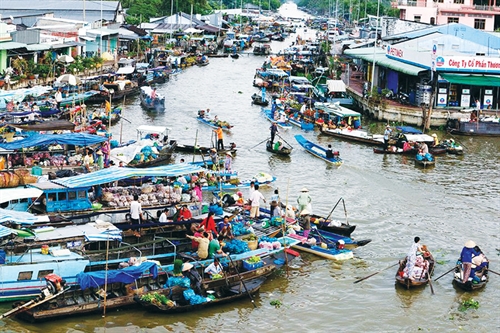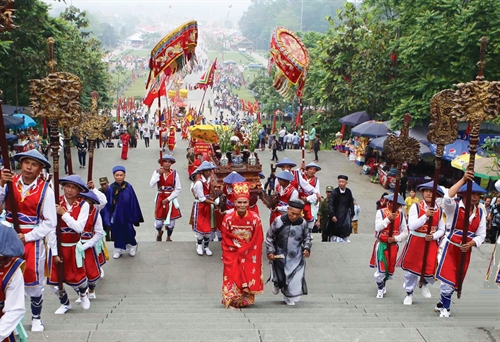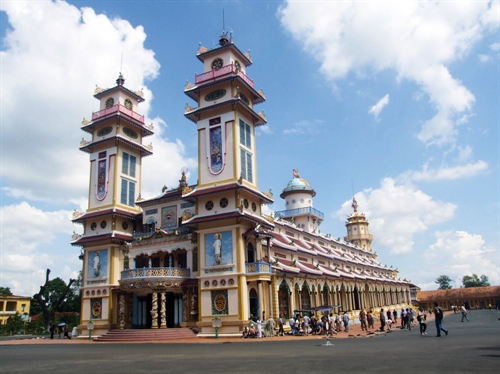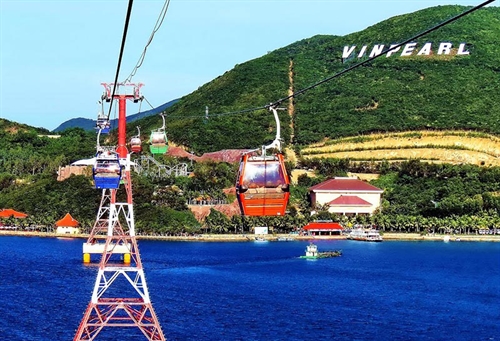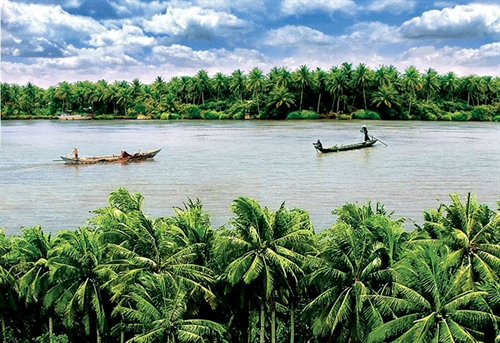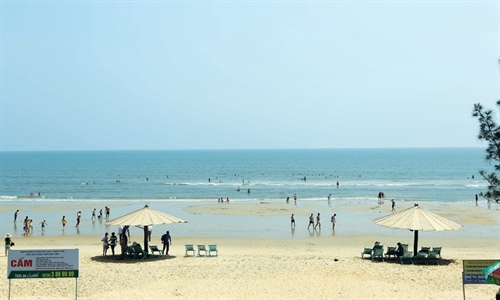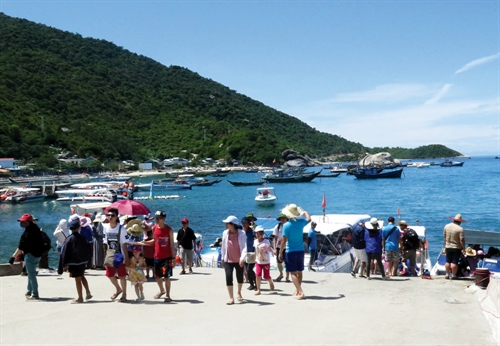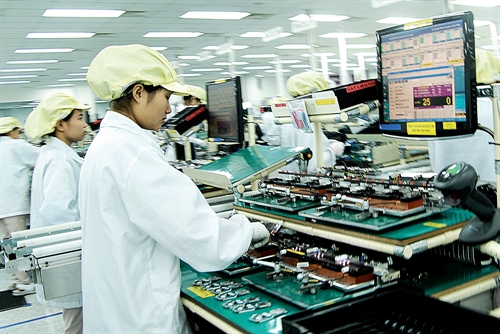As one of the five Central Highlands provinces with no international borderline, Lam Dong province borders Khanh Hoa and Ninh Thuan provinces to the east, Dong Nai province to the southwest, Binh Thuan province to the southeast and Dak Lak province to the north. Covering some 9,772 square kilometers, Lam Dong is the seventh largest province in the country. It has a population of 1.29 million (according to the 2017 figures) and is home to Kinh (Viet) people as the most populous and other ethnic groups, including Churu, Ma, K’ho and M’nong. It has Da Lat and Bao Loc cities and ten districts.
Lam Dong province is connected with the southeastern region, Ho Chi Minh City, other Central Highlands provinces and southern Central Vietnam provinces via national highways 20, 27 and 28.
According to Vice Chairman of the Lam Dong People’s Committee Pham S, the province’s Lien Khuong airport currently serves six domestic flight routes connecting Lam Dong province with Hanoi, Ho Chi Minh City, Da Nang, Vinh city, the former imperial city of Hue and the northern port city of Hai Phong and three international airway routes to Bangkok (Thailand), Wuhan (China) and Incheon (the Republic of Korea) with 32 flights per day.
 |
| A public garden in Lam Dong province’s Da Lat city__Photo: Dang Tuan/VNA |
Economic potentials and FDI attraction
Located on three plateaus of altitude of between 800 and 1,000m above sea level and in the upper reaches of Da Dang, La Nga and Da Nhim rivers, the province boasts big potential of minerals and perennial industrial plants, forestry, tourism, services and livestock breeding.
The province has 150,770 ha of coffee, 18,240 ha of tea, 23,880 ha of cashew, 1,130 ha of pepper, 5,200 ha of strawberry and 6,885 ha of durian plantations.
Lam Dong is leading the country in hi-tech agriculture. It grows crops on nearly 50,000 ha applying hi-tech cultivation methods and more than half of the Japanese enterprises investing in hi-tech agriculture in the country are in Lam Dong, according to the Ministry of Planning and Investment’s Foreign Investment Agency.
Lam Dong recorded a gross regional domestic product (GRDP) of VND 18.1 trillion in the first half of 2018, and ranked 22nd among 63 provinces and cities in the country in the 2017 provincial competitiveness index (PCI).
At present, the province is home to Loc Son and Phu Hoi industrial parks and its 300-ha Tran Phu industrial park which is calling for infrastructure investment.
Luu Trung Duong, head of the provincial Planning and Investment Department’s External Economics Section, said in the first seven months of 2018, Lam Dong granted investment licenses to two new foreign direct investment (FDI) projects totaling USD 5.4 million. “They are the USD- 2.4-million project of the Republic of Korea and the USD-3-million silk production project of China in the Loc Son industrial park”, he elaborated.
“The province has so far attracted 105 FDI projects with a combined registered capital of some USD 539 million, with the Agripacific Holdings Limited from the Netherlands as the top investor in the locality with three projects worth USD 90 million,” he added.
Duong said that the province was calling for FDI in hi-tech agricultural production and high-quality tourism.
Regarding incentives for foreign investors, Duong said Lam Dong was offering the highest incentives provided by the investment law to investors in its districts as those investing in localities with extreme socio-economic difficulties.
In the meantime, foreign investors in Bao Loc city would be entitled to incentives applicable to areas with socio-economic difficulties, he noted.
He went on to say “Investors in national tourism zones of Tuyen Lam, Dan Kia and Dai Ninh lakes and Prenn waterfalls entertainment site in Da Lat city are entitled to forest land rental exemption within the projects’ implementation periods and land and water surface rental exemption for five years. Real estate projects, excluding ecological and convalescent tourism projects, in Da Lat city may be transferred to other investors in accordance with the Law on Real Estate Business, the Land Law and other guiding documents after completing their infrastructure construction.”
In agriculture, investment projects on building greenhouses for vegetable and flower farming are entitled to import duty exemption for imported materials and equipment which are unavailable at home.
The provincial authorities have regularly held direct dialogues with investors to exchange ideas to address their problems and remove their difficulties in order to create the most favorable conditions for investment.
At present, the province produces the best quality tea, vegetable and flower products and ranks second in coffee production. Its tea and coffee products are exported to Canada, China, the European Union, India, Japan, Malaysia, the Middle East and Taiwan while its vegetables and flowers are sold to Australia, Belgium, China, Japan, the Netherlands, the EU, Singapore, Taiwan, Thailand and the US.
Although Lam Dong’s economic value makes up 1.4 percent of the country’s and its per-capita income reaches VND 55 million (USD 2,350), its economic growth rate remains modest, Prime Minister Nguyen Xuan Phuc told provincial authorities at a working session on July 30.
The government leader suggested the province step up developing hi-tech clean agriculture, farm produce processing industry and tourism associated with hi-tech agriculture for fast and sustainable development.
Agro-tourism development
Da Lat in particular and the Central Highlands and Lam Dong province in general are home to unique historical and cultural heritages and spectacular landscapes. Lam Dong is famous for beautiful scenery with French-built villas, picturesque lakes, waterfalls, hills and pine forests. Its famous tourist destinations include Tuyen Lam lake, Than Tho lake (lake of signs), valley of love, Cam Ly and Prenn waterfalls and the world’s biosphere reserves of Cat Tien national park and Lang Biang. Other must-see tourist sites in Da Lat city are Linh Phuoc, Linh Quang, Linh Son and Linh Phong pagodas, Truc Lam Zen Buddhist monastery, and Domaine de Marie church.
In addition to its biennial flower and tea festival, Lam Dong is also well-known for annual gong culture festival, ruou can (fermented rice wine drunk out of a jar using pipes) and brocade weaving products.
Together with conventional tourist destinations, tours of hydroponic vegetable and fruit farms in Lam Dong province are expected to attract more domestic and foreign tourists to the province.
According to the provincial Culture, Sports and Tourism Department, the province received 3.4 million tourist arrivals, including 245,000 foreigners, in the first half of the year.
The province has expanded its tourism cooperation with other localities in the country. It has signed a cooperation agreement with Ho Chi Minh City and Binh Thuan province to form a tourist development triangle with special products of Ben Thanh market, Da Lat flowers and Mui Ne beach.
To tap their tourism potential, Lam Dong and Khanh Hoa provinces’ hospitality sector has planned to propose their provincial People’s Committees to upgrade national highway 27c, and organize training for Russian and Chinese tourist guides and jointly organize a booth at tourism festivals.
At present, the province has three FDI projects in tourism, namely the USD-38.69-million golf course and resort project from Macau, USD-9.69-million resort project of an overseas Vietnamese in Germany and USD-7.55-million resort project of an overseas Vietnamese in France.
The province expects to receive 6.5 million tourist arrivals, including 980,000 foreigners, by 2020.
It plans to establish tourism representative offices in Singapore, Japan and Cambodia and provide tours to high-quality tea, vegetable and fruit farms associated with product advertisement.- (VLLF)
